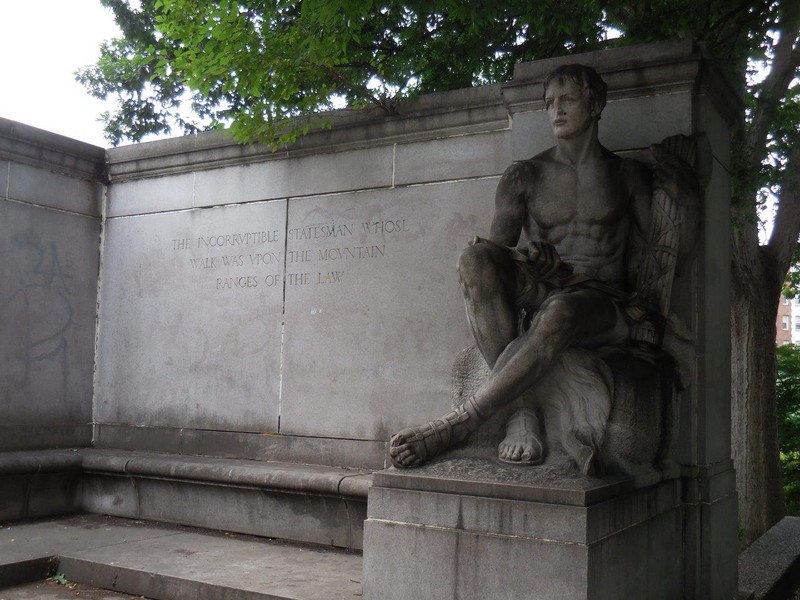James Buchanan Memorial
Introduction
Text-to-speech Audio
Images
James Buchanan Memorial in Washington, D.C.'s Meridian Hill Park

A closer look at the bronze sculpture of Buchanan

"Diplomacy"

"Law"

James Buchanan (1791-1868)

Backstory and Context
Text-to-speech Audio
James Buchanan was born into a wealthy family on April 23, 1791 in Cove Gap, Pennsylvania. His father, a native of Ireland, was a successful merchant. After graduating from Dickinson College in Carlisle, Buchanan studied law and passed the bar in 1812. He then established a prosperous law practice in Lancaster.
Buchanan embarked on his lengthy political career as a Federalist, serving in the Pennsylvania General Assembly from 1814 to 1816. In 1820, he was elected to the U.S. House of Representatives, and subsequently won reelection four times. During his time in the House, the Federalist Party dissolved and Buchanan gravitated toward the Democratic Party. In 1831, President Andrew Jackson, a fellow Democrat, nominated him to be U.S. minister to Russia. Three years later, the people of the Commonwealth of Pennsylvania elected Buchanan to the U.S. Senate. He remained there until 1845, when he resigned to become President James K. Polk’s secretary of state. Buchanan served in the position for Polk’s entire term in office. In 1853, President Franklin Pierce nominated him to be U.S. minister to Great Britain, a post he occupied until March 1856. Later that same year, Buchanan secured his party’s nomination for president of the United States, so doing in large part because he was out of the country during the passage of the controversial Kansas-Nebraska Act. In November, he defeated Republican John C. Frémont and Know Nothing candidate (and former U.S. president) Millard Fillmore in a three-way race.
At the outset of his presidency, Buchanan hoped that a Supreme Court ruling on the legality of restricting slavery in the western territories along with his decision to fill his cabinet with both northerners and southerners would maintain the peace between the nation’s anti-slavery and proslavery contingents. Unfortunately, his federal appointments had little to no effect and the Court’s decision in Dred Scott v. Sanford only divided the nation further. Moreover, Buchanan’s support for the Lecompton Constitution, which would have allowed the Territory of Kansas to be admitted to the Union as a slave state, angered anti-slavery advocates and many northerners. Later, when Republicans achieved a plurality in Congress as a result of the 1858 midterm elections, the federal government reached an impasse when Congress refused to support Buchanan’s agenda and the Democratic president vetoed Republican-sponsored bills.
With the presidential election of 1860 looming, Buchanan followed through on a promise that he made in his inaugural address to not seek reelection. Following Abraham Lincoln victory, seven southern slave states seceded from the Union and formed the Confederate States of America. While Buchanan argued that these states did not have the right to secede, the lame duck president believed that he had no Constitutional authority to stop them. Consequently, he did nothing, leaving the national crisis for his successor. After Lincoln took the oath of office on March 4, 1861, Buchanan retired to Wheatland, his homestead in Pennsylvania, where he died on June 1, 1868 at the age of seventy-seven. His remains were buried at Woodward Hill Cemetery in Lancaster.
In 1903, Harriet Lane Johnston, Buchanan’s niece and ward who served as White House hostess during his time in office, passed away. In her will, she left $100,000 for the erection of a memorial in honor of her beloved uncle in the nation’s capital. Some lawmakers and residents of Washington, D.C. recoiled at the idea of building a memorial to Buchanan when the city did not yet have ones for more revered historical figures such as Thomas Jefferson, John Adams, and James Madison. Others questioned Buchanan’s loyalty to the Union during the Civil War and pondered if he should have a memorial at all. After a decade and a half of debate and delay, Congress finally approved its construction. Dedicated on June 26, 1930 in Meridian Hill Park, the memorial consists of a bronze sculpture of Buchanan on a granite pedestal backed by a long granite exedra designed by architect William G. Beecher. Created by sculptor Hans Schuler, the statue depicts Buchanan sitting in a chair with his head slightly bowed. At the ends of the exedra sit male and female allegorical figures representing “Law” and “Diplomacy.” In attendance at the unveiling were President Herbert Hoover, diplomats, and other government officials.
Sources
Freidel, Frank and Hugh S. Sidey. The Presidents of the United States of America. Washington, DC: White House Historical Association, 2006.
History.com Editors. "James Buchanan." History. A&E Television Networks. 21 August 2018. Web. 10 April 2021 <https://www.history.com/topics/us-presidents/james-buchanan>.
"James Buchanan." DC Memorialist. 4 March 2010. Web. 10 April 2021 <https://dcmemorialist.com/james-buchanan/>.
"James Buchanan Memorial." NPS.gov. U.S. Department of the Interior. 7 February 2021. Web. 10 April 2021 <https://www.nps.gov/places/000/james-buchanan-memorial.htm>.
McKevitt, Stephen R. Meridian Hill: A History. Charleston, SC: The History Press, 2014.
http://www.bradycarlson.com/james-buchanan-memorial/
https://www.presidentsusa.net/buchananstatuemeridianparkdc.html
https://www.presidentsusa.net/buchananstatuemeridianparkdc.html
https://www.presidentsusa.net/buchananstatuemeridianparkdc.html
https://en.wikipedia.org/wiki/James_Buchanan
